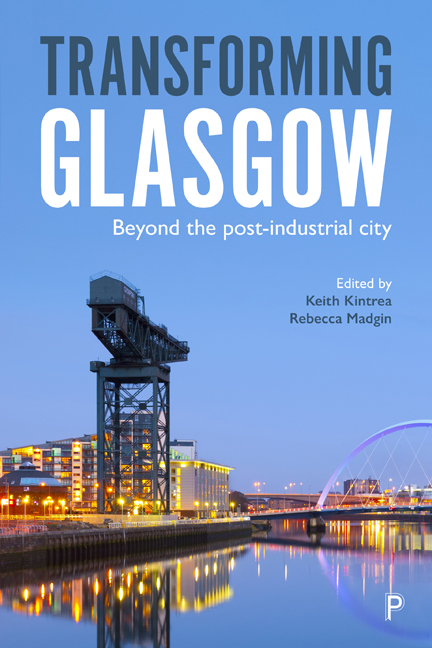Book contents
- Frontmatter
- Contents
- List of Maps, Tables, Figures and Boxes
- Notes on Contributors
- Acknowledgements
- Foreword
- Map
- Introduction: Transforming Post-Industrial Glasgow – Moving Beyond the Epic and the Toxic
- PART I
- PART II
- PART III
- Conclusion: Beyond the Post-Industrial – Narratives of Time and Place
- Index
7 - Dynamic Housing Transformations: Following the Money
Published online by Cambridge University Press: 25 March 2021
- Frontmatter
- Contents
- List of Maps, Tables, Figures and Boxes
- Notes on Contributors
- Acknowledgements
- Foreword
- Map
- Introduction: Transforming Post-Industrial Glasgow – Moving Beyond the Epic and the Toxic
- PART I
- PART II
- PART III
- Conclusion: Beyond the Post-Industrial – Narratives of Time and Place
- Index
Summary
Introduction
Glasgow's 20th-century housing narratives relate primarily to substantial, largely public-funded interventions, each of which sought to address the deplorable housing legacy left by the city's rapid industrialisation. Addressing notorious slum conditions and associated overcrowding drove each transformation, given they impinged on the health and well-being of the city's citizens. While these narratives still carry resonance, Glasgow has moved well beyond addressing the housing consequences of its brutal industrial legacy.
Sustained investment in new council housing, then pursuing the mass demolition of slum property, before, latterly, subsidising the improvement of the remnants of these slums, has given the city a distinctive sectoral housing form. Financial innovations supported each development phase. Access to public financing facilities funded the construction and subsequent modernisation of council housing. The amortised loan heralded a steady growth in owner-occupation, initially facilitating middle-class suburban drift beyond the city's immediate administrative boundaries. Both these innovations challenged the previous primacy of private renting, given its reliance on a funding arrangement whereby fixed-term loans were repaid on securing a new loan. Throughout the 20th century the interplay of class politics, political power and financial products ensured the conurbations’ binary tenure profile, with Glasgow city being three-quarters publicly owned by the mid-1970s, whereas the encircling suburbs reflected the mirror opposite, being three-quarters private.
This continued interplay of finance, politics and class during the 1970s and 1980s reshaped this binary. Previously privately rented property transferred into owner-occupation, a switch lubricated by the advent of downmarket lending and accesses to capital grants for home improvements and repair. Further tenure changes, this time from private renting to local housing associations, were also supported by public funding which facilitated comprehensive tenement renovation. Then the deregulation private finance market, post-1986 not only led to a rationalisation of mortgage providers, but the development of new financial products further enabling the privatisation of housing. The global financial crisis of 2008 then brought about another dramatic reconfiguring of housing finance, which accelerated the move towards the financialisation, whereby housing is now more commonly traded for its value as a monetary product, rather than just for its value as a consumption good.
- Type
- Chapter
- Information
- Transforming GlasgowBeyond the Post-Industrial City, pp. 139 - 158Publisher: Bristol University PressPrint publication year: 2019



